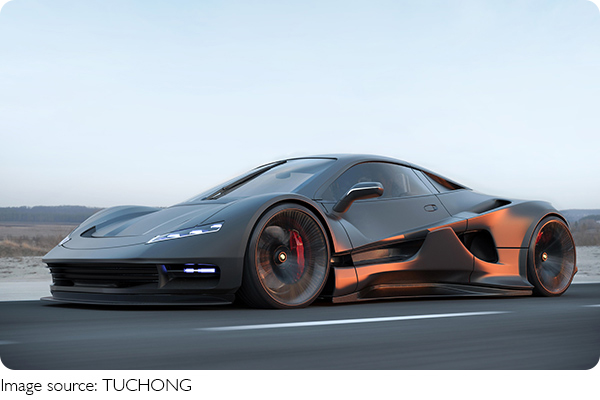Speed Meets Style

Sports cars, as we know them today, began their journey in the early 20th century. The term "sports car" was first coined by Time magazine in 1919, marking the beginning of a new era in automotive engineering.
Initially, these cars were designed for racing purposes, but as technology evolved, they transformed into the high-performance, stylish vehicles we now admire on the roads.
One of the earliest examples of a sports car was the Ford Model T, which, though primarily a utilitarian vehicle, introduced a new style of open-air driving that would later be embraced by the sports car community. The Model T's lightweight body and relatively high speed for its time laid the foundation for future developments.
The Golden Age of European Sports Cars
In the 1920s, European manufacturers began to dominate the sports car scene. Iconic brands like Bentley, Aston Martin, and Jaguar emerged, introducing cars with powerful engines and elegant designs. These cars weren’t just fast—they were also symbols of luxury and refinement.
Bentley, for instance, marketed their vehicles as "supercars," a term that would later define the high-performance vehicles of the 21st century. British manufacturers led the charge in creating cars that were not only fast but also comfortable and stylish.
Meanwhile, Italian manufacturers such as Ferrari and Maserati were pushing the boundaries of automotive engineering, creating vehicles that were faster, more durable, and even more beautiful than their predecessors. These brands would go on to become the hallmark of luxury sports cars.
The Influence of American Muscle Cars
Across the Atlantic, the United States was developing its own unique version of the sports car: the muscle car. In the 1960s, American automakers like Ford and Chevrolet introduced powerful vehicles with large V8 engines, designed for speed and strength. Unlike their European counterparts, these cars were built for raw power and straight-line speed rather than finesse or handling on tight corners.
The Ford Mustang, for example, became an icon of American muscle, offering both performance and a distinctive, aggressive style. While these cars didn’t have the precision handling of European sports cars, they captured the imagination of driving enthusiasts, offering a thrilling driving experience at a more affordable price point.

Modern Sports Cars: Technology and Speed Unite
Fast forward to the present day, and sports cars have evolved into machines that combine speed, luxury, and cutting-edge technology. Today’s vehicles are not only about raw power but also about the precision engineering that makes them capable of handling challenging roads and racing circuits alike.
Brands like Porsche, Ferrari, and Lamborghini continue to lead the way in creating high-performance machines. These vehicles are built with advanced materials like carbon fiber and titanium, which reduce weight and improve speed. They also feature sophisticated suspension systems, state-of-the-art engines, and aerodynamic designs that help them stay stable even at high speeds.
The Porsche 911, for example, has become synonymous with precision handling and performance, while Ferrari and Lamborghini focus on combining speed with jaw-dropping design. These modern sports cars are as much a status symbol as they are a testament to human ingenuity.
Electric Sports Cars: The Future of Speed
As we move into the future, electric sports cars are becoming an increasingly important part of the automotive landscape. With companies like Tesla and Rimac pushing the boundaries of electric car technology, the future of sports cars is taking on a new, eco-friendly twist.
Electric vehicles offer instant torque, meaning that acceleration is virtually instantaneous. This makes them incredibly fun to drive, especially when paired with the sleek design and performance-oriented engineering typical of sports cars. Brands like Tesla and Porsche have already released electric models that deliver exceptional speed and handling.
The Rimac C_Two, for example, is an electric hypercar that combines 1,914 horsepower with a top speed of 258 mph, proving that electric technology can keep up with—and even surpass—traditional combustion engine vehicles in terms of speed and performance.
The Thrill of Driving a Sports Car
At its core, the sports car is all about the experience of driving. Whether it’s the raw power of a muscle car, the refined elegance of a European sports car, or the futuristic performance of an electric model, sports cars are designed to provide an adrenaline rush like no other vehicle on the road.
For car enthusiasts, there’s nothing quite like the feeling of sitting behind the wheel of a high-performance machine, feeling the power of the engine, and taking corners with precision. The symphony of the engine’s roar, the smoothness of the acceleration, and the thrill of speed are what make driving a sports car an unforgettable experience.
A Legacy of Innovation and Performance
From their humble beginnings to their status as icons of speed and luxury, sports cars have continually embraced innovation. With every leap in technology, they’ve become faster, smarter, and more refined. As the automotive world shifts toward cleaner energy and smarter design, sports cars are poised to lead that transformation without losing the thrill they’re known for.
So, Lykkers, are you excited about the rise of electric performance cars, or do you still dream of gripping the wheel of a classic gas-powered beast? Share your thoughts with us—we'd love to hear what fuels your passion for speed!
$50 MILLION HYPERCAR GATHERING IN THE NETHERLANDS!
Video by Gumbal
-
 Drive Clean FutureThink Electric Cars Are Just a Trend? Here’s How They’re Actually Helping Save the Planet!
Drive Clean FutureThink Electric Cars Are Just a Trend? Here’s How They’re Actually Helping Save the Planet! -
 Choosing Right OilChoosing Engine Oil: Are You Picking the Right One for Your Car?
Choosing Right OilChoosing Engine Oil: Are You Picking the Right One for Your Car? -
 Electric Cars Surge!Electric Vehicles Set to Explode in 2025 - Global Car Sales Up by 1.7% with a 30% EV Growth Potential!
Electric Cars Surge!Electric Vehicles Set to Explode in 2025 - Global Car Sales Up by 1.7% with a 30% EV Growth Potential!